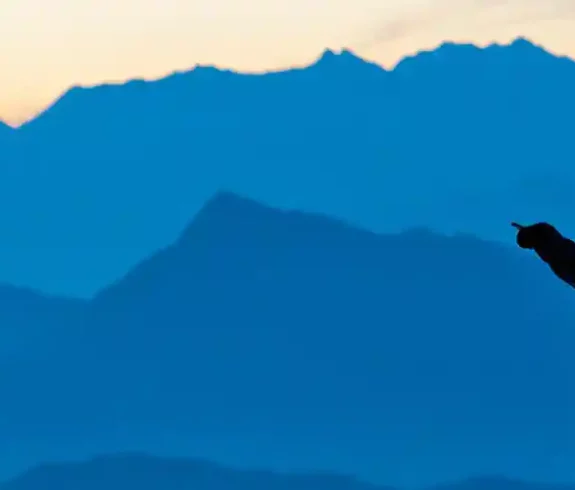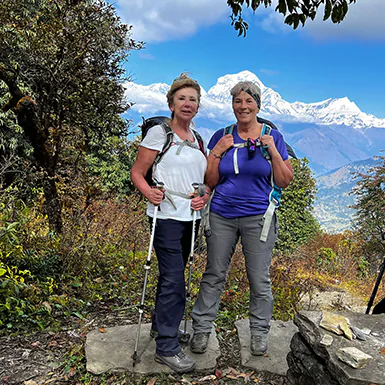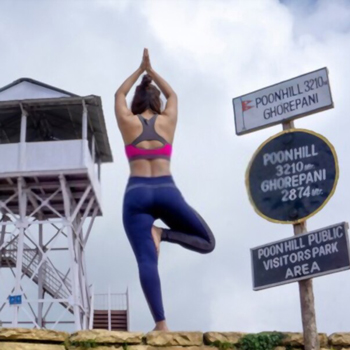Poon Hill Trek Nepal, a renowned trekking spot in the central Annapurna region, lies at an impressive altitude of 3,210 meters (10,531 feet). Offering spectacular vantage points over the majestic Himalayan range, Poon Hill attracts both novice and seasoned trekkers with its moderate difficulty and panoramic views.
Near the charming village of Ghorepani, Poon Hill forms part of the larger Annapurna Circuit. The area earns acclaim for its stunning sunrise scenes, illuminating the snow-capped peaks of Annapurna and Dhaulagiri. Its easy access and breathtaking natural beauty make Poon Hill Trek Nepal a top destination for anyone visiting Nepal.
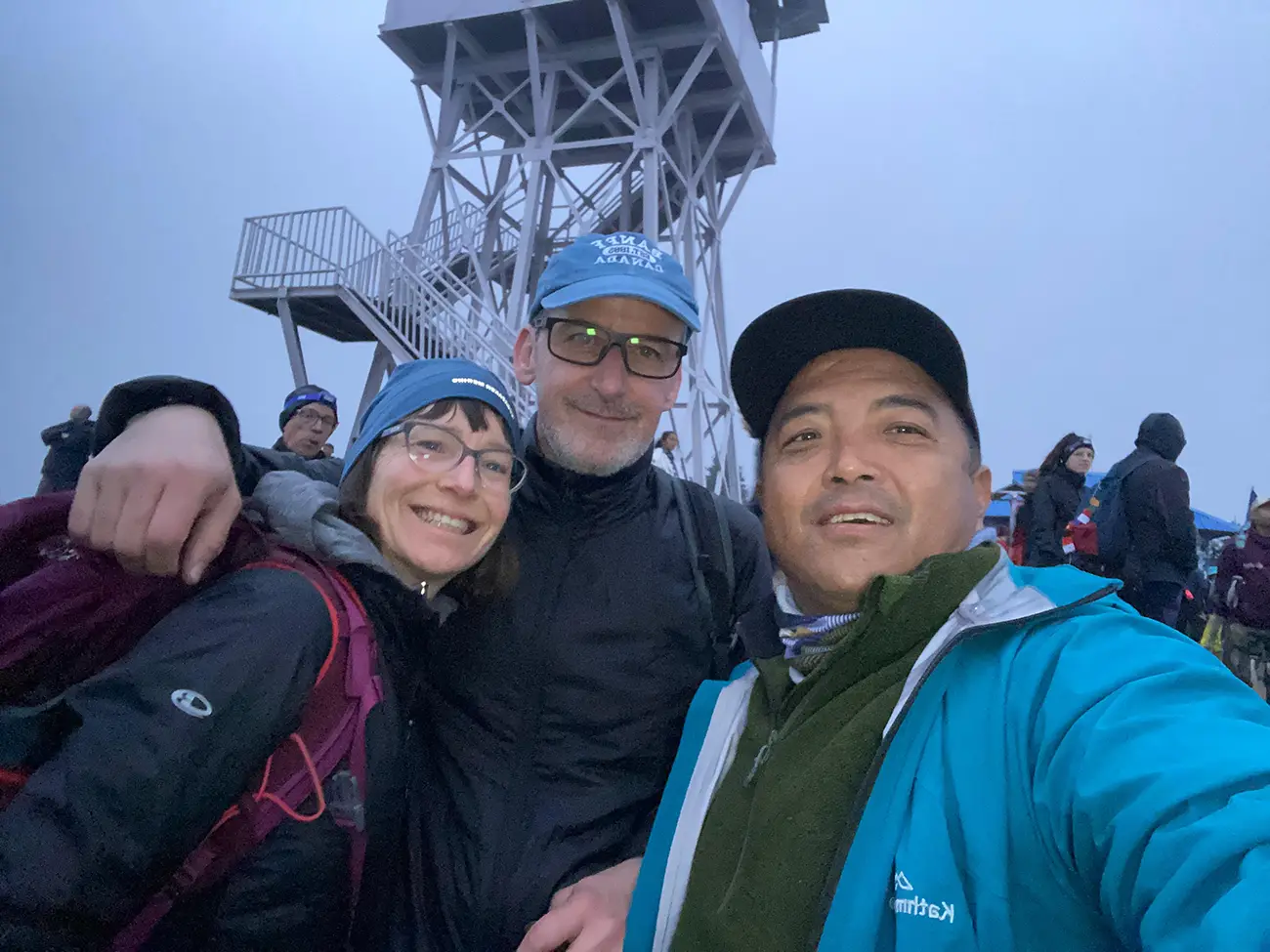
Appeal to Trekkers and Nature Lovers
- Stunning Views: Famous for its sweeping vistas of the Himalayas, including Annapurna South, Machapuchare, Dhaulagiri, and Nilgiri, Poon Hill offers a sunrise experience you’ll never forget. As the golden light reveals the towering peaks, the scene creates a mesmerizing display of nature’s grandeur.
- Accessibility: Poon Hill’s trek is among Nepal’s more accessible paths. Typically, it requires 2-4 days, depending on your pace and starting point. The well-marked and maintained trail welcomes trekkers of all skill levels. Its proximity to Pokhara, a major tourist center, enhances the ease of planning and execution.
- Cultural Experience: Trekking through traditional villages like Ghorepani, you encounter the rich culture of the Gurung and Magar communities. Staying in homestays, interacting with locals, and savoring conventional Nepali cuisine enrich your trek with cultural depth.
- Rich Biodiversity: The trek through lush rhododendron forests, particularly vibrant in spring, showcases the area’s diverse flora and fauna. Nature enthusiasts have the opportunity to observe the region’s wildlife up close.
- Year-Round Trekking: Poon Hill welcomes trekkers all year. Each season transforms the landscape, from winter’s snow-covered paths to spring’s blooming flowers, offering a unique perspective every time.
- Comfortable Accommodation: The trek route, especially around Ghorepani, features numerous tea houses and lodges. These establishments are well-equipped to meet trekkers’ needs, ensuring comfortable and trouble-free accommodations.
Geographical Location and How to Reach Poon Hill Trek Nepal
Poon Hill Nepal, perched in the Annapurna region’s heart, stands at 3,210 meters (10,531 feet). This prime location offers trekkers some of the most spectacular views in central Nepal, establishing it as a top destination for those seeking breathtaking scenery and adventure.
Routes to Poon Hill Nepal
The Poon Hill Trek Nepal begins in Pokhara, a hub for adventurers and a gateway to the treks in the Annapurna Region. From here, travelers typically head to Nayapul, marking the start of their trek.
- From Pokhara to Nayapul: A 1.5-hour drive from Pokhara brings you to Nayapul. This route, characterized by well-maintained roads, winds through picturesque countryside, showcasing terraced fields and rolling hills.
- Nayapul to Tikhedhunga Trek: Starting at Nayapul, the path follows the Modi Khola River’s banks. It meanders through quaint villages and lush forests, eventually leading to Tikhedhunga after about 4-5 hours. This village, known for its hospitality, often hosts trekkers overnight.
- Trekking from Tikhedhunga to Ghorepani: Early the following day, you will leave Tikhedhunga again and trek the mountain to Ghorepani in the trekking circuit. The segment has a steep ascent on stone stairs that lead to Ulleri but also promises an adventurer the ability to reach the summit, which is Ghorepani. Ghorepani is one of the most visited places at 2,874 meters above sea level or 9,429 feet because it’s near Poon Hill and has decent hotels.
- Final Ascent to Poon Hill: The last part of the trek involves a brief but exhilarating climb from Ghorepani to Poon Hill. Trekkers often start this ascent around 4:00 AM to catch the famous Poon Hill Sunrise. The hike, lasting about 45 minutes to an hour, builds anticipation with each step. Upon arriving, you receive a stunning panorama of the Annapurna and Dhaulagiri ranges, bathed in the early morning light.
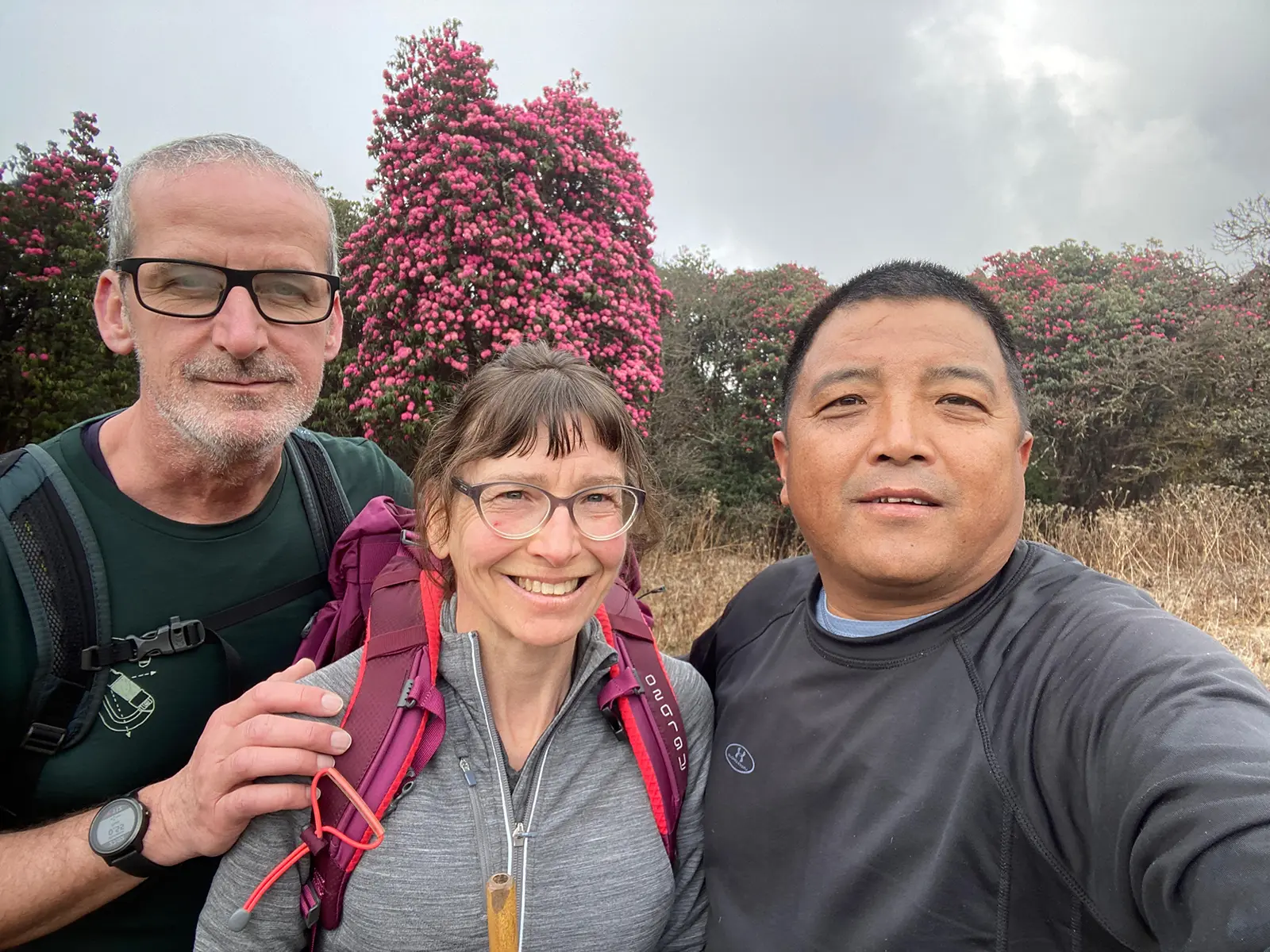
Ghorepani Poon Hill Trek Nepal Overview
The Ghorepani Poon Hill Trek Nepal is one of Nepal’s most favored routes, perfectly blending natural beauty with cultural immersion. The trek begins at Nayapul, a quaint town accessible by road from Pokhara. It leads through charming villages, lush rhododendron forests, and terraced fields, providing a deep insight into the traditional lifestyles of the local communities.
Main Stops on the Ghorepani Poon Hill Trek
- Nayapul: The trek starts at Nayapul, where trekkers can enjoy the scenic views along the Modi Khola River. The well-marked trail is beginner-friendly and easy to follow.
- Tikhedhunga: After trekking for a few hours, you arrive at Tikhedhunga, a small village surrounded by verdant landscapes. Many trekkers prefer to rest here before tackling the next leg of the trek.
- Ulleri: The trek continues to Ulleri, known for its challenging stone staircase. Although this part of the trek can be demanding, the stunning views from Ulleri make the climb worthwhile.
- Ghorepani: Following Ulleri, you reach Ghorepani, a beautiful village at 2,874 meters (9,429 feet). Ghorepani is a popular overnight stop, providing comfortable lodging and breathtaking views of the nearby mountains.
- Poon Hill: The trek’s highlight is the early morning hike from Ghorepani to Poon Hill. This short, 45-minute climb rewards trekkers with a stunning panorama of the Annapurna and Dhaulagiri ranges. Witnessing the Poon Hill Sunrise as the first light touches the snow-capped peaks is a moment to treasure.
Poon Hill Trek Nepal Duration and Difficulty
Usually, the Ghorepani Poon Hill Trek Nepal takes between four to five days, depending on your pace and how long you stop. You will cover a moderate distance with steep climbs like the stairs at Ulleri. However, most trekkers, including beginners, can find the trek accessible due to well-maintained paths and frequent rest points. On this moderate difficulty level of a trek, one can enjoy breathtaking views and cultural experiences that many adventurers may participate in.
The Ghorepani Poon Hill Trek Nepal truly becomes an unforgettable experience because of its stunning landscapes and rich cultural diversity in Poon Hill, Nepal. Whether you are already an experienced hiker or are visiting the region for the first time, this hike is an excellent opportunity to explore the country’s natural beauty while getting closer to its local communities through their warm hospitality.
Poon Hill Altitude and Weather
Poon Hill Nepal, perched at 3,210 meters (10,531 feet), is a prominent viewpoint in the Annapurna region. At this elevation, trekkers enjoy unmatched views of Himalayan peaks such as Annapurna South, Machapuchare, and Dhaulagiri. The altitude at Poon Hill significantly enhances the trekking trip.
Most trekkers, even those new to high-altitude trekking, find Poon Hill’s moderate altitude manageable. Mild altitude sickness symptoms like headaches or shortness of breath may occur, but the route’s gradual ascent and numerous acclimatization opportunities generally offset these effects. Key strategies such as staying hydrated, pacing yourself, and resting in places like Ghorepani greatly diminish the risks associated with high altitude.
Weather Patterns at Poon Hill Nepal
The weather at Poon Hill changes drastically across the seasons, influencing both trekking conditions and visibility. Knowing these seasonal variations is crucial for timing your visit and ensuring optimal trekking conditions.
Spring (March to May): Springtime is ideal for visiting Poon Hill Trek Nepal. The mild weather, with daytime temperatures between 10°C and 15°C (50°F to 59°F), and clear skies ensure excellent visibility for mountain views. The blooming rhododendron forests along the trek add color to the scenic landscape.
Summer/Monsoon (June to August): During the monsoon season, heavy rains make the trails muddy and slippery, and low clouds can obscure mountain views. Sponges are also more prevalent. Despite these challenges, the lush, green landscape and fewer trekkers can create a serene experience. Be prepared for wet conditions and limited visibility if you trek during this period.
Autumn (September to November): Autumn marks the peak trekking season at Poon Hill Trek Nepal. Enjoy trekking in stable weather with clear skies and pleasant temperatures for outdoor activities. Clear views of the Himalayas are almost guaranteed, making it a popular choice, so expect busier trails.
Winter (December to February): Trekking offers a distinct experience with snow-covered paths and fewer fellow trekkers. Daytime temperatures hover between 5°C and 10 °C (41°F to 50°F), occasionally dropping below freezing at night. The winter landscape offers a serene and peaceful experience despite the cold weather and potential snow.
Optimal Times to Visit Poon Hill Nepal
The Ghorepani Poon Hill hike offers the most pleasant experience during spring and autumn. These seasons provide stable weather, excellent visibility, and comfortable trekking temperatures. If you want peace and have provisions for coldness, then winter is the best time to enjoy Poon Hill’s serenity when there are fewer tourists.
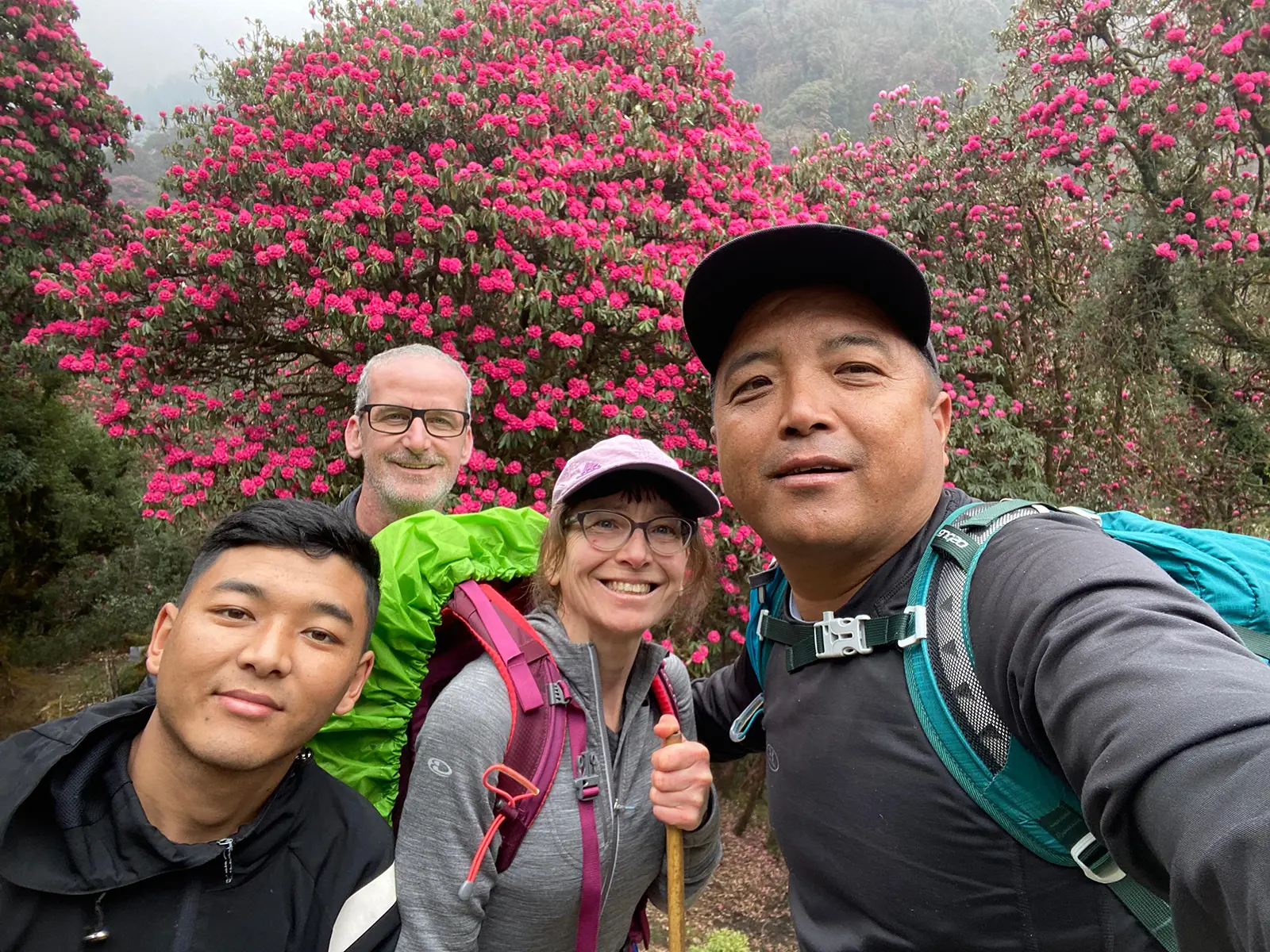
Poon Hill Sunrise Experience
Every Poon Hill Trek Nepal climaxes with the iconic Poon Hill sunrise, the trek’s central highlight. Before the dawn breaks, trekkers from around the world begin the pre-dawn hike to capture the sunrise at this legendary vantage point. The thrill of seeing the day’s first light paint the Himalayas is truly memorable.
This trek starts from Ghorepani at about 4:00 a.m. Equipped with headlamps and well-warmed clothing, the hikers ascend a slope for 45 minutes. Even inexperienced climbers can take it since the trail is visible and ascends; it is easy to follow, and several people come despite the darkness. Just before reaching the top, you will see a stunning view during early sunrise.
Panoramic Majesty from Poon Hill
Upon reaching Poon Hill’s peak at 3,210 meters (10,531 feet), trekkers encounter a breathtaking panorama that validates their early morning efforts. The sunrise casts the first light on Annapurna and Dhaulagiri, turning the snow-covered peaks into a golden spectacle.
From Poon Hill, the view spans 360 degrees and features some of the highest mountains in the world. The towering forms of Annapurna South, Machapuchare, and Dhaulagiri dominate the horizon, complemented by other majestic peaks. The hues transform from deep oranges to soft pinks as the sun climbs, captivating everyone watching.
Why You Must Witness the Poon Hill Sunrise
Witnessing a Poon Hill dawn is rewarding and engages with the rawness of nature’s untouched beauty. Indeed, it is an important event, with tranquility around almost all trekkers, crisp mountain air, and a sense of awe shared among trekkers. Not only does this sunrise reveal the Himalayas, but it also provides an unfathomably deep perspective that awes and grounds.
For many families, the Poon Hill Trek Nepal concludes with a sunrise, thereby making traveling footsteps much more worthwhile. Unique adventure can be created by moderate altitudes at Poon Hill, together with exceptional sights enjoyed during trekking. Whether you are an experienced hiker or a beginner looking for an unforgettable experience, witnessing the sunrise at Poon Hill will stay in your memory long after dropping off from the mountains.
Cultural Insights and Local Communities Along the Poon Hill Trek Nepal
The Poon Hill Trek Nepal transcends mere hiking; it immerses trekkers in the vibrant tapestry of Nepali culture, mainly through interactions with the Gurung and Magar communities. Known for their hospitality and colorful traditions, these indigenous groups maintain cultural richness that has endured for generations.
As you trek through the Annapurna region’s villages, you’ll engage directly with the Gurung and Magar peoples’ traditional lifestyles. Every town along the Ghorepani Poon Hill route showcases rural Nepali life, where ancient practices seamlessly integrate with everyday activities.
Opportunities for Cultural Exchange
The trek to Poon Hill, Nepal, is rich with opportunities for cultural exchange, enhancing the trekking experience. In villages like Ulleri and Ghorepani, local homestays give visitors an intimate look at Nepali family life, offering insights into their customs, cuisine, and daily routines.
- Homestays: Engaging with a Gurung or Magar family’s life offers a profound cultural experience. You might find yourself helping to prepare meals or enjoying traditional Nepali dishes, gaining insights into the local way of life, and forming lasting bonds.
- Cultural Performances: Some villages host cultural performances that display traditional dances and music, enriching visitors’ understanding of the Gurung and Magar cultural heritage. These events are entertaining and educational, providing a deeper context to the communities’ rich traditions.
- Crafts and Weaving: The Gurung and Magar communities are also skilled in crafts and weaving. Local homestays and shops often sell handmade items, like baskets and traditional clothing. Buying these crafts supports the local economy and helps preserve these communities’ artistic traditions.
Interacting with the Local People
Connecting with locals during the Ghorepani Poon Hill Trek Nepal significantly enriches the hiking experience. Many trekkers highlight these interactions as the most memorable aspects of their trek, offering personal insights that no guidebook can match.
- Language and Communication: Although Nepali is the common language, many community members, particularly the youth, speak some English. Learning basic Nepali phrases or local dialect expressions can deepen interactions and show respect for their cultural norms.
- Community Activities: Community-led activities, such as a village clean-up or a local festival, deepen the cultural exchange. These contributions help sustain the communities that enhance the Poon Hill Trek Nepal experience.
Flora and Fauna of Poon Hill Nepal
Poon Hill is captivated by its stunning vistas and rich biodiversity. As you trek along the Ghorepani Poon Hill route, you’ll encounter a variety of ecosystems, each showcasing unique flora and fauna.
- Rhododendron Forests: The rhododendron forests along the Poon Hill Trek Nepal are among its most striking features, especially during the spring months of March to May, when they burst into vibrant bloom. These forests, awash in red, pink, and white rhododendron flowers, provide a breathtaking backdrop against the towering Himalayas. This vibrant display draws nature lovers and photographers from all over.
- Flora: Beyond rhododendrons, the region boasts a diverse array of plant species, including oak, pine, and magnolia trees. As you ascend, the vegetation transitions, with alpine meadows and scrublands becoming more prevalent at higher altitudes. This variety in plant life enhances the trek’s scenic beauty, offering a constantly evolving landscape.
- Fauna: Poon Hill Trek Nepal shelters a wide range of wildlife. Trekkers might spot Himalayan tahr, a wild goat species, or even the elusive snow leopard, although sightings are rare. Birdwatchers will enjoy the area’s diverse birdlife, including the colorful Danphe (Himalayan Monal), Nepal’s national bird, and the vibrant Scarlet Minivet. The forests come alive with the calls of these birds, turning the trek into a feast for the senses.
Accommodation and Amenities Along the Poon Hill Trek Nepal
Accommodation on the Poon Hill Nepal trek Nepal typically consists of tea houses and lodges scattered along the trail. These establishments offer basic yet comfortable facilities, ensuring trekkers have a restful night before continuing their trek.
Tea Houses and Lodges: Ghorepani, the main stop before the Poon Hill Trek Nepal, hosts numerous tea houses and lodges that cater to trekkers. Rooms are usually simple, featuring twin beds and shared bathroom facilities. However, some lodges offer rooms with attached bathrooms for an extra fee. Tea houses often have communal dining areas where trekkers can unwind and share experiences over a hot meal.
Amenities Available: The tea houses and lodges along the Ghorepani Poon Hill Trek Nepal provide essential amenities to ensure a comfortable stay. These include:
- Food: Lodges may serve an array of food choices, ranging from popular Nepali plates such as dal bhat (rice with lentil soup) to favorite meals like pasta and pancakes. These three main meals include breakfast, lunch, and supper, which consist primarily of solid, energy-rich foods meant to keep trekkers complete throughout the day.
- Water: The most significant resource for trekkers is clean drinking water. The tea houses generally provide boiled or filtered water at a small cost. Hikers should carry reusable water bottles or purification tablets to avoid contributing to plastic waste.
- Electricity and Charging: Most stops have electricity, although it may be limited, particularly during peak seasons. Some tea houses offer charging facilities for electronic devices, often for an additional charge. Carrying a portable power bank is advisable.
- Hot Showers: Hot showers are generally available, although they may cost extra. After a long day of trekking, a warm shower offers much-needed comfort, especially at higher altitudes where temperatures drop.
- Basic Supplies: Some tea houses sell basic trekking supplies, snacks, and toiletries, though prices tend to rise with altitude. It is recommended that essential items be packed in advance.
Best Time to Visit Poon Hill Nepal
Choosing the best time for Poon Hill Trek Nepal depends on your desired experience. The most popular trekking seasons are pre-monsoon (spring) and post-monsoon (autumn), offering unique views and experiences.
Spring (March to May): Spring is a favorite season for many who visit Poon Hill. Enjoy pleasant daytime temperatures of 10°C to 15°C during this period. The rhododendron forests come alive with vibrant blooms, adding color and beauty to the trek. Clear skies during spring offer excellent visibility of the Annapurna and Dhaulagiri ranges, making the Poon Hill Sunrise a breathtaking experience. However, expect more trekkers on the trails, as this is a popular time to visit.
Autumn (September to November): Autumn is the best season for Poon Hill Trek Nepal. The weather is predictable, with clear skies and temperatures between 10°C and 20°C. The post-monsoon atmosphere ensures crisp air and crystal-clear mountain views, providing some of the most stunning panoramas in the Himalayas. Comfortable temperatures make trekking enjoyable, though the trails can be busy due to the popularity of this season.
Winter (December to February): Winter offers a quieter and unique trekking experience at Poon Hill. Daytime temperatures range from 5°C to 10°C (41°F to 50°F), with the possibility of temperatures dropping below freezing at night. Although the cold presents challenges, trekkers who venture out during winter enjoy snow-covered trails and serene landscapes, with far fewer people on the trails.
Summer/Monsoon (June to August): The monsoon season typically isn’t recommended for trekking due to heavy rains, slippery trails, and leeches. However, those who trek during summer find a lush, green landscape and significantly fewer trekkers. If you trek this season, prepare for wet conditions and limited visibility.
Conclusion: Why Poon Hill Trek Nepal Should Be on Your Bucket List
Poon Hill Trek Nepal truly shines as a must-visit spot for trekkers and nature enthusiasts. The trek seamlessly blends stunning natural beauty, rich cultural experiences, and the unforgettable sight of a Poon Hill Sunrise over the Himalayan peaks.
Poon Hill is an awe-inspiring viewpoint at a height of 3210m and home to some of the world’s famous hills, such as Annapurna and Dhaulagiri, which are known for their marvelous beauty. But the vibrant rhododendron forests, diverse wildlife, and ever-changing landscapes make the trek memorable.
The cultural diversity of the Ghorepani Poon Hill Trek Nepal is another enchanting aspect of this trek. Poon Hill offers the possibility to interact with friendly Gurungs and Magars communities, who provide an extra layer of understanding about Nepal’s rich cultural heritage to enhance the trekking experience.
However, the sunrise at Poon Hill is the most compelling reason to visit. Watching the first light touch the snow-capped peaks is a magical experience. This moment lingers long after the trek ends, leaving a lasting impression.
[contact-form-7 id=”bec8616″ title=”Inquiry From – Blog”]
